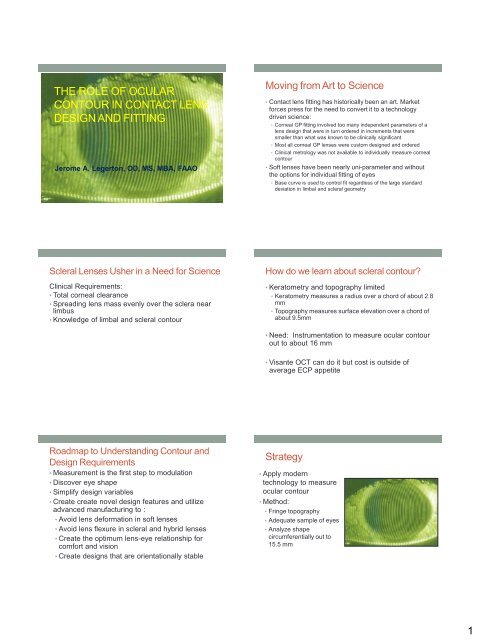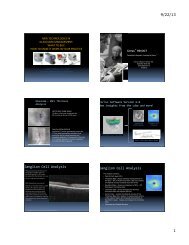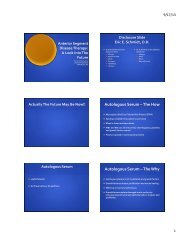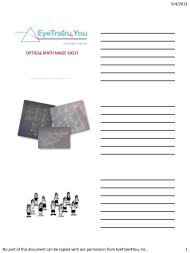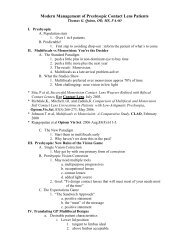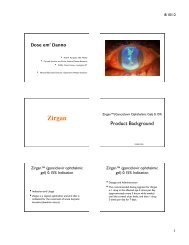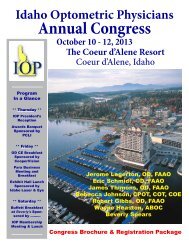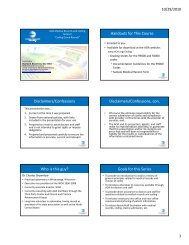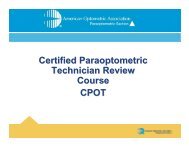You also want an ePaper? Increase the reach of your titles
YUMPU automatically turns print PDFs into web optimized ePapers that Google loves.
THE ROLE OF OCULARCONTOUR IN CONTACT LENSDESIGN AND FITTINGJerome A. Legerton, OD, MS, MBA, FAAOMoving from Art to Science• <strong>Contact</strong> lens fitting has historically been an art. Marketforces press for the need to convert it to a technologydriven science:• Corneal GP fitting involved too many independent parameters of alens design that were in turn ordered in increments that weresmaller than what was known to be clinically significant• Most all corneal GP lenses were custom designed and ordered• Clinical metrology was not available to individually measure cornealcontour• Soft lenses have been nearly uni-parameter and withoutthe options for individual fitting of eyes• Base curve is used to control fit regardless of the large standarddeviation in limbal and scleral geometry<strong>Scleral</strong> <strong>Lenses</strong> Usher in a Need for ScienceClinical Requirements:• Total corneal clearance• Spreading lens mass evenly over the sclera nearlimbus• Knowledge of limbal and scleral contourHow do we learn about scleral contour?• Keratometry and topography limited• Keratometry measures a radius over a chord of about 2.8mm• Topography measures surface elevation over a chord ofabout 9.5mm• Need: Instrumentation to measure ocular contourout to about 16 mm• Visante OCT can do it but cost is outside ofaverage ECP appetiteRoadmap to Understanding Contour andDesign Requirements• Measurement is the first step to modulation• Discover eye shape• Simplify design variables• Create create novel design features and utilizeadvanced manufacturing to :• Avoid lens deformation in soft lenses• Avoid lens flexure in scleral and hybrid lenses• Create the optimum lens-eye relationship forcomfort and vision• Create designs that are orientationally stableStrategy• Apply moderntechnology to measureocular contour• Method:• Fringe topography• Adequate sample of eyes• Analyze shapecircumferentially out to15.5 mm1
Fringe TopographyWhat did we learn about ocular contour?A new technology formeasuring the cornea andscleral surface shape hasbeen developed in theDepartment of Optometryat the Beuth Hochschulefor Applied Sciences atBerlin, Germany. Global<strong>Contact</strong> No.2/2009(52)Precision measurement of ocular sag every 60 microns of chord over 15.5 mm0 0.06 0.12 0.18 0.24 0.3 0.36 0.42 0.48 0.54 0.6 0.66 0.72 0.78 0.84 0.9 0.960 0.002302 0.006083 0.010255 0.014707 0.021918 0.02698 0.032601 0.036583 0.043705 0.051786 0.060478 0.06819 0.075681 0.084563 0.092945 0.1038160 0.001329 0.002908 0.004338 0.005507 0.007736 0.010835 0.014525 0.018684 0.023823 0.029262 0.034311 0.039131 0.04467 0.051099 0.058258 0.0662870 0.001232 0.002564 0.004226 0.006098 0.00895 0.011612 0.014734 0.020186 0.026258 0.03126 0.037081 0.042443 0.046195 0.051727 0.060049 0.0686410 0.001105 0.003301 0.004596 0.005292 0.007657 0.010202 0.011308 0.012343 0.013469 0.015734 0.019949 0.025655 0.03095 0.035495 0.039451 0.0452460 0.002963 0.007667 0.01047 0.012323 0.012156 0.01398 0.014403 0.016006 0.01879 0.022703 0.026226 0.024539 0.030923 0.032526 0.039639 0.0468130 0.000496 0.002262 0.004108 0.007234 0.01083 0.013237 0.015643 0.019469 0.023235 0.027091 0.031167 0.036673 0.044169 0.050975 0.056251 0.0615280 -0.001451 0.000278 0.004427 0.007396 0.008625 0.009194 0.010723 0.014922 0.020522 0.025091 0.03163 0.040489 0.046878 0.050857 0.055586 0.063715Contour Data for Mean EyeContour Data to Six Standard DeviationsAverage Sag OD (mm)4.543.532.521.510.50-8.5 -8 -7.5 -7 -6.5 -6 -5.5 -5 -4.5 -4 -3.5 -3 -2.5 -2 -1.5 -1 -0.5 0 0.5 1 1.5 2 2.5 3 3.5 4 4.5 5 5.5 6 6.5 7 7.5 8 8.5-0.5Average Sag OS(mm)4.543.532.521.510.5OD n = 93 Nasal TemporalSemi-chord (mm) 6.48 -5.22 5.22 q -6.48 qAverage Sag (mm) 3.00 1.95 41.8 1.88 2.81 38.7Standard Deviation (mm) 0.259 0.128 4.067 0.080 0.162 3.3160-8.5 -8 -7.5 -7 -6.5 -6 -5.5 -5 -4.5 -4 -3.5 -3 -2.5 -2 -1.5 -1 -0.5 0 0.5 1 1.5 2 2.5 3 3.5 4 4.5 5 5.5 6 6.5 7 7.5 8 8.5-0.5The Enigma of <strong>Scleral</strong> ContourConvex Landing Zone GeometryRed = Mean eye profileGreen = Lens with concavescleral zoneBlack = Lens with uncurvedscleral zoneBlue = Lens with convextoward scleraEven a scleral zone having no curvature will bury into the scleraA convex curve toward the eye is required to create edge lift(Patent pending)Red = Mean ScleraGreen = Standard concave to eyeBlack = Un-curved targeted to touch at 13.0 mmBlue = Convex to eye targeted to touch at 13.0 mm2
Contour Based <strong>Scleral</strong> Lens DesignPrescribed Limbal ClearanceApical Clearance = 0.080 mmLimbal Clearance = 0.080 mmAxial Edge Lift = 0.050 mmTouch Diameter = 13.0 mmPosterior OZ = 8.0 mmOver-All Diameter = 15.5 mmIdeal geometry with prescribed apicalclearance, limbal clearance and axial edge liftIndependent Landing Zone AngleRed = Mean eye profileOrange = Corneal radiuscontinued through scleral zoneThree Moving Parts• Base Curve Radius:• Suggested increments of 0.4 mm from 6.60 to 8.60• Connecting Zone Depth• Modulated in microns in 50 micron steps• Landing Zone Angle• Single convex to eye radius modulated in 1° stepsA single convex radius can be prescribed with selected “curve angles”to produce the desired edge lift as observed by flourescein patternKey Lens Chords•J1 = 8.0mm; junction of BCR andconnecting zone•J2 = 10.5mm; junction ofconnecting zone and landing zone•“Node” 3 = 13.0mm; location ofmid-point of convex to eye landingzoneThe Notion of Nodes13.010.58.0OD n = 93 Nasal TemporalSemi-chord (mm) 6.48 -5.22 5.22 q -6.48 qAverage Sag (mm) 3.00 1.95 41.8 1.88 2.81 38.7Standard Deviation (mm) 0.259 0.128 4.067 0.080 0.162 3.3163
Sag (mm)0.000-1.450-3.7000 45 90 135 180 225 270 315 360Semi-Meridian (deg)8.0 Chord10.5 Chord13.5 ChordCalculating Sag at 3 “nodes”• BCR Mean 7.80 mm• Sag = 1.104 at 8.0 mm• RZD Mean = 0.850• Sag at 10.5 = 1.954 mm(1.104 + 0.850)• LZA Mean = 56°• Sag at 13.0 = 3.029 mm(1.954 + 1.075)BCR 8.0 Sag RZD8.0-10.5 ∆Sag LZA10.5-13.0∆ Sag6.60 1.350 0.650 0.650 48 0.7996.80 1.301 0.700 0.700 49 0.8317.00 1.256 0.750 0.750 50 0.8637.20 1.213 0.800 0.800 51 0.8967.40 1.174 0.850 0.850 52 0.9307.60 1.138 0.900 0.900 53 0.9657.80 1.104 0.950 0.950 54 1.0008.00 1.072 1.000 1.000 55 1.0378.20 1.042 1.050 1.050 56 1.0758.40 1.013 1.100 1.100 57 1.1138.60 0.987 1.150 1.150 58 1.1538.80 0.962 1.200 1.200 59 1.1949.00 0.938 1.250 1.250 60 1.2379.20 0.915 1.300 1.300 61 1.2809.40 0.894 1.350 1.350 62 1.3269.60 0.873 1.400 1.400 63 1.3731.450 1.450 64 1.421Asymmetric <strong>Scleral</strong> Contour• Deepest• Superior Nasal• Shallowest• TemporalNote: Inferior Temporalis not equal to superiornasal-0.050-0.100-0.150-0.200-0.250-0.300-0.350-0.400-0.450-0.500-0.550-0.600-0.650-0.700-0.750-0.800-0.850-0.900-0.950-1.000-1.050-1.100-1.150-1.200-1.250-1.300-1.350-1.400-1.500-1.550-1.600-1.650-1.700-1.750-1.800-1.850-1.900-1.950-2.000-2.050-2.100-2.150-2.200-2.250-2.300-2.350-2.400-2.450-2.500-2.550-2.600-2.650-2.700-2.750-2.800-2.850-2.900-2.950-3.000-3.050-3.100-3.150-3.200-3.250-3.300-3.350-3.400-3.450-3.500-3.550-3.600-3.650-3.750-3.800-3.850-3.900-3.950-4.000OD - Variation with meridianDual Axis Landing Zone• The Dual Axis feature allows the lens to have a varyingsagittal depth in one meridian compared to another whilemaintaining a spherical base curve• As a rule, the vertical meridian of the sclera is deeper thanthe horizontal. The dual axis feature maintains:• more uniform sag circumferentially• eliminates flexure• provides orientational stability that enables front surfacetoric or HOA correctionOpportunityA new scleral lens using the same logic and lexicon asParagon CRT:Base Curve RadiusReturn Zone DepthLanding Zone AngleDual Axis:Controls flexureProvides orientation and stabilityEliminates mid peripheral bubblesFront surface cylinder / decentered multifocalA scleral lens with edge lift:Tear exchangeEase of removalFitting <strong>Scleral</strong> <strong>Lenses</strong>Fitting <strong>Scleral</strong> <strong>Lenses</strong>1. Select parameters from the periphery tothe center• Landing Zone Angle must demonstrateedge lift and clearance at the 10.5 mmchord (50 microns)• Dx set with mean Landing Zone Angle• No edge lift = decrease angle• Excess edge lift = increase angle2. Select the RZD to provide total corneal clearance• Elevation data from corneal topography can beextrapolated to derive the sag at 10.5 mm• Sag of the optic zone at 8 mm derived from lookup tables using the base curve radius• RZD lifts the optic zone of the lens to causeoptic zone junction and lens apex to clear thecorneal surface by at least 30 microns• OZ touching = RZD too shallow• Bubbles under OZ = RZD too deep4
Fitting <strong>Scleral</strong> <strong>Lenses</strong>3. Select a base curve radius that flatter than theflat keratometry value• Result will be optic zone and apicalclearance from the shallowest cornealmeridian when the RZD lifts the lens• Clearance from steepest meridian will begreater than flat meridian at optic zonejunction• Exception with ectasia in KC. Fit referencesphere selected by corneal topographerFinal Fit Success Criteria• Minimal edge lift of 30 to 50 microns• Clearance at 10.5 mm chord (J-2) of 50 microns• Clearance through optic zone of at least 80microns• Lens movement on push up• Dual axis to control flexure• No impingement of conjunctival vessels• No bubbles over cornea greater than 1 mmA Word About Diagnostic <strong>Lenses</strong>• No scleral lens can be successfully fit empirically withoutimaging- The majority of practitioners do not have anterior segmentimaging with precision metrology (OCT)• Diagnostic lenses are required- The greater the number of diagnostic lenses the higher theprobability of getting it right the first timeEVALUATING THEINITIAL DIAGNOSTICLENS• Re-orders are a lose-lose-lose situation- Greater chair time- Greater inconvenience for the patient- Higher cost for the laboratoryThe White Magic: Design + Material + an Efficient Fitting SystemNormalEyes 15.5 Look-up TableSelect yourstarting diagnosticlens using the flatkeratometrymeridian value:Step 1: Find ideal LZASelect parameters from the periphery to thecenter• Landing Zone Angle must demonstrateedge lift and clearance at the 10.5 mmchord (50 microns)• Dx set with mean Landing Zone Angle• No edge lift = decrease angle• Excess edge lift = increase angle5
Landing Zone Angle Selection• The LZA is the only parameter that can produce properedge lift AND proper clearance at 10.5 mm chord (J2). Itdoes so simultaneously–Edge lift control with the LZA• Less angle is more lift and more angle is less lift• A greater LZA reduces edge lift and increases clearanceat 10.5 mm (J2)• A lesser LZA increases edge lift and reduces clearanceat 10.5 mm–The lens must have clearance at J2Lack limbal of clearance is seen as a black arcDual Axis Landing Zone• The modal eye has 300µ of elevation difference at the13 mmchord from highest to lowest.• The dual axis feature maintains:– more uniform sag circumferentially– minimizes flexureShallowDeep– provides orientational stability that enables front surfacetoric or HOA correction.• The Dual Axis feature allows the lens to have a varyingsagittal depth in one meridian compared to another whilemaintaining a spherical base curveEffect of LZA Differences• One degree of LZA change raises and lowers the edge lift andJ2 clearance about 50 microns• The point of maximum touch is at the 13.0 mm chord in a wellfit lens.• Increasing the LZA moves the edge down and J2 up• Decreasing the LZA moves the edge up and J2 down• The RZD must be adjusted when the LZA is changed to keepthe same optic zone clearance from the cornea• If the LZA is increased, the RZD must be decreased• If the LZA is decreased, the RZD must be increased• Consider a 50 µ RZD change for every 1°LZA change• Increase LZA then decrease RZD• Decrease LZA then increase RZDImpact of Each Degree of Change in LZABCR 8.0 Sag RZD8.0-10.5 ∆Sag LZA10.5-13.0∆ Sag6.60 1.350 0.650 0.650 48 0.7996.80 1.301 0.700 0.700 49 0.8317.00 1.256 0.750 0.750 50 0.8637.20 1.213 0.800 0.800 51 0.8967.40 1.174 0.850 0.850 52 0.9307.60 1.138 0.900 0.900 53 0.9657.80 1.104 0.950 0.950 54 1.0008.00 1.072 1.000 1.000 55 1.0378.20 1.042 1.050 1.050 56 1.0758.40 1.013 1.100 1.100 57 1.1138.60 0.987 1.150 1.150 58 1.1538.80 0.962 1.200 1.200 59 1.1949.00 0.938 1.250 1.250 60 1.2379.20 0.915 1.300 1.300 61 1.2809.40 0.894 1.350 1.350 62 1.3269.60 0.873 1.400 1.400 63 1.3731.450 1.450 64 1.42135 microns46 micronsLZA Too ShallowBlack ARC touch Inside limbusEvaluating LZALZA Adjusted HigherStill too shallow; See black arc bearing at 10.5 (A) ;and excessive edge lift (B)Excessive Edge LiftABB6
Evaluating LZAShallow LZA will immediately show excessive edge liftand dark ring at limbusEvaluating LZA• 54 / 58 LZA is too shallow post compressionNote Inadequate limbal clearance and apical clearanceInadequate ClearanceEvaluating LZA• Consider a1°increase inLZA• Will loweredge by 40µand raiselens at 10.5mm chordby 40µEdge Lift is good butcheck for limbal clearanceExcessiveEdge LiftBlack Arc Bearing at J2Conjunctival “Blanching” Indicates LZA isToo DeepIdeal LZAIdeal Fit After Conjunctival CompressionProper Clearance7
Selection of RZDEVALUATING THE RZDSELECTION• Select the RZD to provide total corneal clearance• RZD lifts the optic zone of the lens to causeoptic zone junction and lens apex to clear thecorneal surface by at least 50 microns postcompression• OZ touching = RZD too shallow• Bubbles under OZ = RZD too deepFitting <strong>Scleral</strong> <strong>Lenses</strong> with TopographyTopography Chord Value – 10.5 mm (J2)• Close determinationof initial BC fromElevation Map (BestFit Sphere).• Close determinationof initial RZD fromsagittal depthanalysis at the givenjunctionsSag at the 10.5 mm chord is 1950 micronsTopography Chord Values – 8 mm (J1)Calculating the RZD from TopographySag DataA=10.5mm(J2) B= 8.0mm(J1)J 1B : Sag at 8.0 mmSag at the 8 mm chord is 1090 micronsA : Sag at 10.5 mmRZD = A - BEstimated RZD 1950 – 1090 = 860 micronsJ 28
RZD and LZA Too ShallowRZD Too Deep and LZA GoodPost lens tear film too deepNot enough central clearanceExcessive centralclearanceInsufficient Limbal ClearanceEdge lift is goodIdeal Corneal ClearanceGoal is 80 to 100µm AFTER conjunctivalcompression or 200 to 240 µm before compression.Use Parallel Pipette for RZDEvaluationCornea is about 550 µmLens is about 240 µmThis post lens tear filmabout equal to lensthicknessBest evaluated with parallel pipette or OCTBase Curve CalculationBASE CURVECALCULATIONSelected using• Flat meridian keratometry• Flatter than flat K from lens selection chart• Reference sphere from corneal topography• For irregular corneas• If too steep:• Lens will be closer at J1 than at the apex and may facilitate centralbubble• If too flat:• Lens will be closer at apex than J1 and may facilitate central touch orarccuate bubble at J1Base Curve is not very critical if RZD and LZA are correct9
NormalEyes 15.5 Look-up Table• Select your startingdiagnostic lens usingthe flat keratometrymeridian value:• Recommended BCRis flatter than Flat Kfor normal corneas• Least criticalparameter• Usually in 0.4 mmsteps• Can be ordered in0.1 mm incrementsBase Curve Radius Too FlatMinimal centralclearance(pre compression)Arccuate bubble at J1Base Curve Radius Too SteepProper Base Curve Radius/RZD/LZACentral bubble captureAdequate centralclearanceInsufficient limbal clearanceAcceptable limbalclearance (precompression)Appropriateedge liftA Word About Chair TimeFINAL FIT SUCCESS• Free to evaluate within seconds of lensapplication• Evaluate immediately upon application• Finesse conjunctival compression: Averageknown to be 120 microns• Apply second or third lenses in short serialsuccessionGet it right the first time by having an adequatediagnostic set and observing a series of lenses ifneeded10
Final Fit Success Criteria/post-Compression• Minimal edge lift of 30 to 50 microns• Clearance at 10.5 mm chord (J-2) of 50 microns• Clearance through optic zone of at least 80 microns• Lens movement on push up• Dual axis to control flexure; if flexure observedincrease thickness• No impingement of conjunctival vessels• No bubbles over cornea greater than 1 mmIdeal Fit After ConjunctivalCompressionAn Easy-to-Fit <strong>Scleral</strong> LensA rational 3 Zone Lens with Independent FittingZones• <strong>Scleral</strong> Contour measurement derived rangesand increments• Diagnostic Sets for all cornea types• Get it right the first time• Thinnest scleral lens offered today• Dual Axis controls flexure and providesorientational stabilityNature Hides on the Side of the Flaw• The Wild Card• Conjunctival compression• Conjunctiva thicker closer to the limbus (120 microns)• Thinner 1.5 mm from limbus (70 microns)• Must compensate in RZD for conjunctivalcompressionLearnings from Clinical Trials• Amazing Comfort• Technique still required to remove lenses• Don’t use abrasive cleaners• Can apply lenses with Optifree Express• Don’t need non-preserved saline• Dual Axis nails flexure• Multifocals provide great vision• Chair time reduced with 36 lens Dx set for regular cornea• 24 additional Dx lenses for ectasia (KC, Pellucid and Post Graft)• 12 additional Dx lenses for post surgicalAPPLYING OCULARCONTOUR TO SOFTLENS DESIGN11
Soft Lens History and Outcome• First lens manufacturing circa 1965 – 1970• Spin casting• Diamond turning on single axis lathesBoth resulted in lenses that were either monocurveor bi-curve as extensions of rigid corneal lensdesign• Discovery that base curve radius had to be muchflatter than the keratometry valuesUse of base curve radius to control sagittal depthFlaw of Use of Base Curve Radius• Lens required to “drape” central cornea whilerequiring either circumferential stretching oversclera or causing scleral indentation= Lens Deformation• Lens deformation causes loss of optical integrity• Limits the ability to correct higher order aberrations• Limits simultaneous multifocal performance• <strong>Scleral</strong> indentation causes variable lens comfort• One size fits all results in variable indentation orcompression from eye to eye• Has impact on end of the day comfortNeed – Shift Control of Sag to thePeriphery of the LensApply same logic and design concepts tosoft lenses as used in scleral lens• Select base curve close to the central keratometry valueto avoid draping and random deformation• Select the overall diameter from the corneal diameter(HVID) to have equivalent extension from limbus on alleyes• Control the sag by Landing Zone Angles• Apply convex to the eye geometry in the landing zoneT H A N K Y O U12


